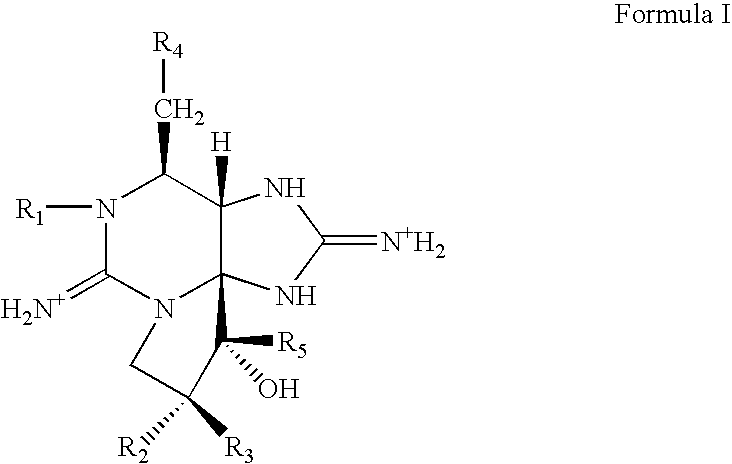Transdermal administration of phycotoxins
a technology of phycotoxins and transdermal administration, which is applied in the direction of biocide, drug compositions, muscular disorders, etc., can solve the problems of inherently unstable enzymes, negative aesthetic effects of people's neck and face, and block neuronal transmission,
- Summary
- Abstract
- Description
- Claims
- Application Information
AI Technical Summary
Benefits of technology
Problems solved by technology
Method used
Image
Examples
example 1
Cosmetic Gel for Treatment of Wrinkles
[0088]
Ethoxydiglycol6.500%w / wLaureth-71.000%w / wDiazolidinyl urea0.300%w / wMethylparaben0.150%w / wPropylparaben0.050%w / wHydroxyethyl cellulose1.500%w / wToxins GTX2 / GTX30.01-0.0001%w / wWater to100%w / w[0089]Purpose of ingredients:[0090]Ethoxydiglycol: Penetration-enhancer (organic solvent)[0091]Laureth-7: Penetration enhancer (surfactant)[0092]Diazolidinyl urea, Methylparaben, Propylparaben: Preservatives[0093]Hydroxyethyl cellulose: Thickener
Compounding Procedure:
[0094]Dissolve all ingredients, except for hydroxyethyl cellulose, in water and mix to make a clear, uniform solution. Disperse the hydroxyethyl cellulose polymer with vortex mixing and continue mixing without vortex until a smooth, clear gel forms.
examples 2-4
Creams for Topical Administration
[0095]
Cream No 1Ingredient% w / wWater to100.00Propylene glycol5.00Glyceryl monostearate4.50Squalene4.50Propylene glycol dicaprylate / caprate4.00Cyclomethicone3.00Cetyl lactate2.50DMDM hydantoin (and) Iodo propynyl butyl carbamate0.15Glyceryl stearate / PEG 100 stearate0.80PVM / MA decadiene crosspolymer0.25Triethanolamine0.16Alpha tocopherol (and) ascorbyl palmitate (and) lecithin0.05(and) glyceryl stearate (and) glyceryl oleate (and) citricacidEDTA disodium0.02Toxins GTX2 / GTX30.01-0.0001
[0096]
Cream No 2Ingredients% w / wWater to100.00Polyglyceryl methacrylate5.00Hydrogenated polyisobutene5.00Propylenglycol5.00Propylenglycol dicaprylate / caprate4.00Cetylic alcohol3.00Cyclomethicone2.00Diazolidinyl urea (and) methylparaben (and)1.00propylparaben (and) propylene glycolCetearylic alcohol (and) ceteareth 200.70Methyl glucose dioleate0.50Triethanolamine0.28Alpha tocopherol (and) ascorbyl palmitate (and)0.05lecithin (and) glyceryl stearate (and) glyceryl oleate(and...
example 5
Ointment
[0098]
Petrolatum75.000% w / wSorbitan sesquioleate10.000% w / wWhite Wax10.000% w / wToxins GTX2 / GTX30.01-0.0001%Water to100%
Purpose of Ingredients:[0099]Petrolatum: Emollient ointment base[0100]Sorbitan sesquioleate: Emulsifier, penetration enhance[0101]White Was: Thickener, Stabilizer
Compounding Procedure:
[0102]Melt the petrolatum, sorbitan sesquioleate and white wax at 60 degrees C. and mix until uniform. Slowly incorporate the aqueous solution of toxin and continue mixing until the ointment congeals.
PUM
| Property | Measurement | Unit |
|---|---|---|
| molecular weight | aaaaa | aaaaa |
| molecular weight | aaaaa | aaaaa |
| thick | aaaaa | aaaaa |
Abstract
Description
Claims
Application Information
 Login to View More
Login to View More - R&D
- Intellectual Property
- Life Sciences
- Materials
- Tech Scout
- Unparalleled Data Quality
- Higher Quality Content
- 60% Fewer Hallucinations
Browse by: Latest US Patents, China's latest patents, Technical Efficacy Thesaurus, Application Domain, Technology Topic, Popular Technical Reports.
© 2025 PatSnap. All rights reserved.Legal|Privacy policy|Modern Slavery Act Transparency Statement|Sitemap|About US| Contact US: help@patsnap.com

